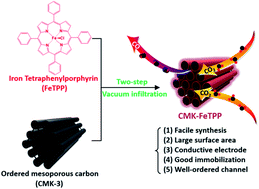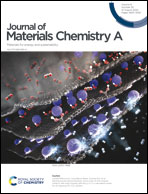Highly ordered mesoporous carbon/iron porphyrin nanoreactor for the electrochemical reduction of CO2†
Abstract
A variety of carbon materials such as carbon nanotubes and graphene have been widely investigated as conductive substrates to immobilize metal complex-based catalysts for electrocatalytic CO2 reduction. However, highly ordered mesoporous carbons have received scant attention as substrates for CO2 reduction electrocatalysts. The unique porous structure of such carbon provides the opportunity to not only house catalytically active materials but also facilitate reactant transport. In this work, we propose a simple approach for immobilization of the highly active and cost-efficient molecular catalyst iron porphyrin, into a highly ordered mesoporous carbon, CMK-3 having a large surface area of 1345 m2 g−1via a simple vacuum infiltration method. The resulting heterogeneous electrocatalyst (CMK-FeTPP) is utilized for the conversion of aqueous CO2 into CO with 92.1% faradaic efficiency and a high effective turnover frequency of 3.9 s−1 at an overpotential of 680 mV. We believe that this new approach has the potential to be widely used to fabricate efficient electrocatalysts for not only CO2 conversion but also other electrochemical gas conversion systems.

- This article is part of the themed collection: Journal of Materials Chemistry A HOT Papers


 Please wait while we load your content...
Please wait while we load your content...